 | |
| Type | Hoe |
|---|---|
| Place of origin | Korea |
| Associated cuisine | Korean cuisine |
| Main ingredients | Long arm octopus |
- Drunken shrimp , shrimp sometimes eaten alive in Chinese cuisine
- Ikizukuri , the preparation of sashimi from living animals
- Odori ebi , shrimp eaten alive in Japanese cuisine, and odorigui , the general practice involving seafood
Related Research Articles

Korean cuisine is the set of foods and culinary styles which are associated with Korean culture. This cuisine has evolved through centuries of social and political change. Originating from ancient agricultural and nomadic traditions in Korea and southern Manchuria, Korean cuisine reflects a complex interaction of the natural environment and different cultural trends.

Hoe is a Korean seafood dish that is eaten by trimming raw meat or raw fish. In addition to fish, it is also made with other marine products such as shrimp and squid, raw meat of land animals, and vegetable ingredients, but without any special prefix, it mainly refers to raw fish.
Odori ebi is a sushi delicacy of Japan, and a form of sashimi. The sushi contains baby shrimp that are still alive and able to move their legs and antennae while being eaten. The meal is prepared quickly to keep the shrimp alive, and when it is eaten the shrimp are usually dunked into sake so as to intoxicate the shrimp, then into a special dipping sauce, and finally quickly chewed to kill it.

Poke is a dish of diced raw fish tossed in sauce and served either as an appetizer or a main course.
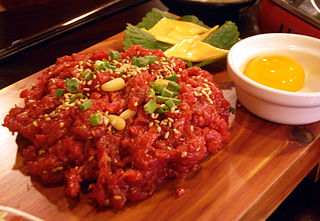
Yukhoe is a raw meat dish in Korean cuisine. It is most commonly made of beef but it can come in various kinds and cuts of meat.

Gopchang (Korean: 곱창) is a dish in Korean cuisine. It can refer to either the small intestines of cattle, the large intestines of pigs, or a gui made of the small intestines. The latter is also called gopchang-gui. The tube-shaped offal is chewy with rich elastic fibers.

Squid is eaten in many cuisines; in English, the culinary name calamari is often used for squid dishes. There are many ways to prepare and cook squid. Fried squid is common in the Mediterranean. In New Zealand, Australia, the United States, Canada, and South Africa, it is sold in fish and chip shops, and steakhouses. In Britain, it can be found in Mediterranean 'calamari' or Asian 'salt and pepper fried squid' forms in various establishments, often served as a bar snack, street food, or starter.

Ssam are dishes in Korean cuisine where one food is wrapped in another. A common variety is meat such as pork wrapped in a leafy vegetable. It is often accompanied by the condiment ssamjang and can also be topped with raw or cooked garlic, onion, green pepper, or a banchan such as kimchi. Ssam is usually bite-sized to prevent spilling of the fillings.

Gejang (Korean: 게장) or gejeot (게젓) is a variety of jeotgal, or salted fermented seafood in Korean cuisine, which is made by marinating fresh raw crabs in either ganjang or a chili pepper powder based sauce. The term consists of the two words; ge, meaning "a crab", and jang which means "condiment" in Korean. The crabs selected for the Gejang dish are mainly female crabs with eggs.

Nakji-bokkeum (Korean: 낙지볶음) or stir-fried octopus is a popular dish in Korea that is relatively recent, with origins dating back only two centuries and first being introduced in the early 1960s.

The practice of eating live seafood, such as fish, crab, oysters, baby shrimp, or baby octopus, is widespread. Oysters are typically eaten live. The view that oysters are acceptable to eat, even by strict ethical criteria, has notably been propounded in the seminal 1975 text Animal Liberation, by philosopher Peter Singer. However, subsequent editions have reversed this position. Singer has stated that he has "gone back and forth on this over the years", and as of 2010 states that "while you could give them the benefit of the doubt, you could also say that unless some new evidence of a capacity for pain emerges, the doubt is so slight that there is no good reason for avoiding eating sustainably produced oysters".

Dojo nabe is a Japanese nabemono dish. To prepare the dish, pond loaches are cooked in a hot pot. The freshwater fishes are either killed ahead of cooking or are first soaked in cold sake and then cooked alive.

Eating live animals is the practice of humans eating animals that are still alive. It is a traditional practice in many East Asian food cultures. Animals may also be eaten alive for shock value. Eating live animals, or parts of live animals, may be unlawful in certain jurisdictions under animal cruelty laws. Religious prohibitions on the eating of live animals by humans are also present in various world religions.
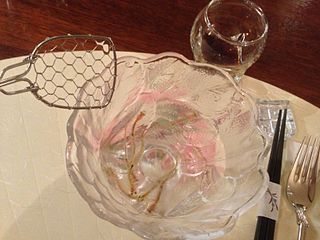
Odorigui is a mode of seafood consumption in Japanese cuisine.
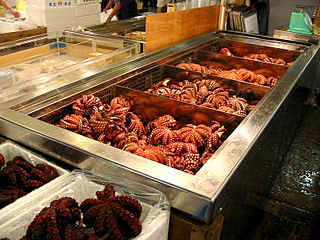
People of some cultures eat octopus. The arms and sometimes other body parts are prepared in various ways, often varying by species and/or geography.
Being eaten alive may refer to the act of being consumed while still living, or more colloquially to the act of overwhelming someone.
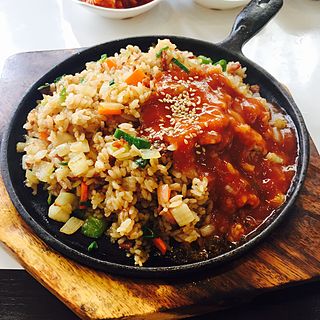
Bokkeum-bap (Korean: 볶음밥) or fried rice is a Korean dish made by stir-frying bap with other ingredients in oil. The name of the most prominent ingredient other than cooked rice often appears at the very front of the name of the dish, as in kimchi-bokkeum-bap.
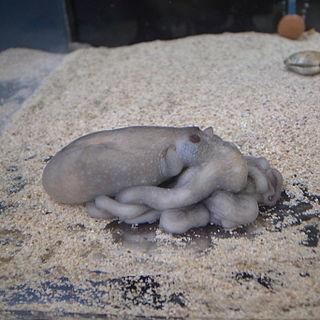
Octopus minor, also known as the long arm octopus or the Korean common octopus, is a small-bodied octopus species distributed along the benthic coastal waters bordering China, Japan, and the Korean Peninsula. It lives at depths ranging from 0 to 200 metres. O. minor is commonly found in the mudflats of sub-tidal zones where it is exposed to significant environmental variation. It is grouped within the class Cephalopoda along with squids and cuttlefish.
References
- ↑ "san-nakji" 산낙지. Standard Korean Language Dictionary (in Korean). National Institute of Korean Language . Retrieved 22 February 2017.
- ↑ Rosen, Daniel Edward (4 May 2010). "Korean restaurant's live Octopus dish has animal rights activists squirming". New York Daily News . Retrieved 3 June 2017.
- ↑ Han, Jane (14 May 2010). "Clash of culture? Sannakji angers US animal activists". The Korea Times . Retrieved 4 June 2017.
- ↑ Compton, Natalie B. (17 June 2016). "Eating a Live Octopus Wasn't Nearly as Difficult As It Sounds". Munchies. VICE . Retrieved 4 June 2017.
- ↑ Hochner, B. (2012). "An Embodied View of Octopus Neurobiology". Current Biology. 22 (20): R887–R892. doi: 10.1016/j.cub.2012.09.001 . PMID 23098601.
- ↑ Yekutieli, Y.; Sagiv-Zohar, R.; Aharonov, R.; Engel, Y.; Hochner, B.; Flash, T. (2005). "Dynamic model of the octopus arm. I. Biomechanics of the octopus reaching movement". J. Neurophysiol. 94 (2): 1443–58. doi:10.1152/jn.00684.2004. PMID 15829594.
- ↑ "Eating Live Octopus". National Geographic. Archived from the original on 2014-04-25. Retrieved 2018-01-13.
- ↑ Warwick, Joe (30 January 2015). "The truth about Noma's live prawn dish". The Guardian . Retrieved 3 June 2017.
- ↑ "The Most Dangerous Foods in the World". Condé Nast Traveler. Retrieved 2018-01-18.
- ↑ Yonhap News 2008-01-21 광주서 산낙지 먹다 기도막힌 사고 잇따라
- ↑ Dodgson, Lindsay (2019-05-11). "Here's why eating a live octopus can be deadly". Insider.
- ↑ "82-year-old man in South Korea chokes to death after eating live octopus". The Straits Times. 25 October 2023. Retrieved 3 December 2023.
- ↑ "Eight controversial foods from around the world". The Times of India.
| Fish | |
|---|---|
| Shellfish | |
| Other seafood | |
| Processed seafood | |
| Seafood dishes | |
| Health hazards | |
| Advisory services | |
| Animal welfare | |
| Related topics | |